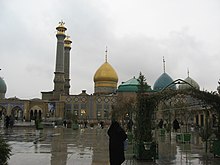Shah-Abdol-Azim shrine
| Shah-Abdol-Azim Shrine شاه عبدالعظیم |
|
|---|---|
 |
|
| Basic information | |
| Location | Rey, Iran |
| Geographic coordinates | 35°35′08″N 51°26′07″E / 35.58556°N 51.43528°ECoordinates: 35°35′08″N 51°26′07″E / 35.58556°N 51.43528°E |
| Affiliation | Shia Islam |
| Municipality | Rey County |
| Province | Tehran Province |
| Architectural description | |
| Architectural type | Mosque |
| Completed | 9th century |
The Shāh Abdol Azīm Shrine (Persian: شاه عبدالعظیم), located in Rey, Iran, contains the tomb of ‘Abdul ‘Adhīm ibn ‘Abdillāh al-Hasanī (aka. Shah Abdol Azim). Shah Abdol Azim was a fifth generation descendant of Hasan ibn ‘Alī and a companion of Muhammad al-Taqī. He was entombed here after his death in the 9th century.
Adjacent to the shrine, within the complex, include the mausolea of Imamzadeh Tahir (son of the fourth shia Imam Sajjad) and Imamzadeh Hamzeh (brother of the eighth Twelver Imām - Imām Reza).
Abdol Azim migrated to Rayy out of persecution and subsequently died there. A piece of paper was found in his pocket outlining his ancestry as being: ‘Abdul ‘Adhīm son of ‘Abdillāh son of ‘Alī son of Husayn son of Zayd son of Hasan ibn ‘Alī. Shah Abdol Azim was sent to Rayy ( Modern day Tehran) by Imam Reza. His journey was full of hardships but he successfully reached there and delivered the message of Imam. He was one of the pious persons of his time. During his journey many spies of Abbasid Caliph Al-Matawakkil tried to capture him but failed. A movie on the life of Shah Abdol Azim Al-Hasani has been made and is available in Persian and Urdu languages.
The whole construction consists of a portal with a lofty Iwan decorated with mirrors, several courtyards, a golden cupola, two tile minarets, a portico, a sepulcher, and a mosque.
The most historical and portable relic of this holy place, is its costly box which is made of betel-nut wood. On four sides of this precious box, a relief inscription in Nastaliq and Thuluth characters, is carved. The inscription ends with the date 1330 CE, and the name of the maker of the box, i.e., Yahya ibn Muhammad al-Isfahani.
...
Wikipedia
